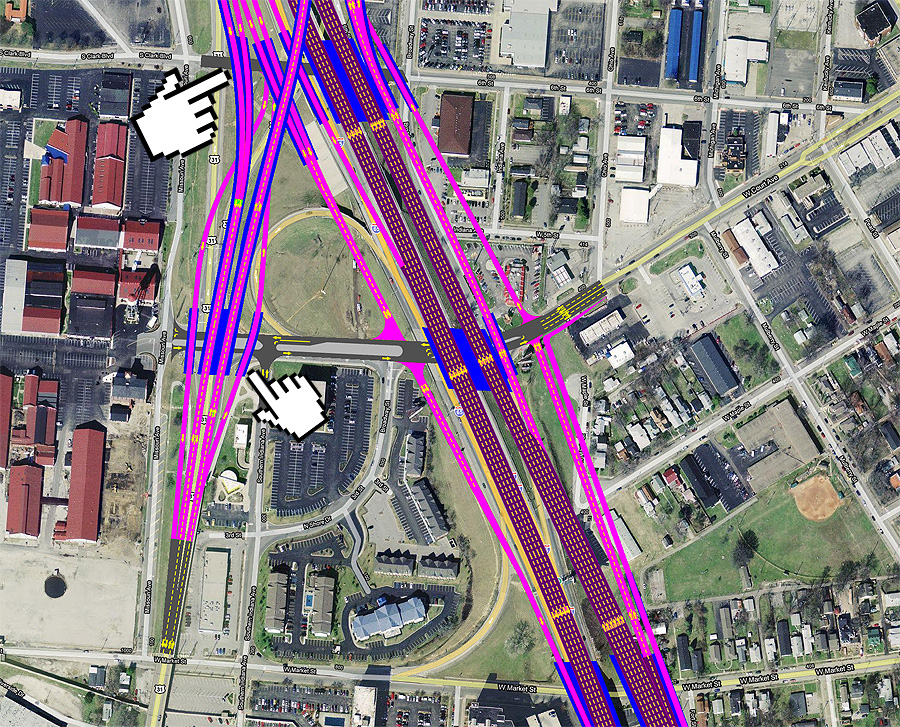
It’s been a while since I dissected the unpublicized and unknown components of the Ohio River Bridges Project (the really scary stuff is over here). There are a couple more over at 8664.org – here and here. This time, let’s take a look at how Interstate 65 interfaces with Southern Indiana between Clarksville and Jeffersonville.
First, take a look at the Second Street Bridge. Today, the bridge terminates at Court Avenue (the bottom arrow). After the Bridges Project (ORBP), however, you will be forced to take an off-ramp from the bridge which deposits you on an extended Sixth Street in Jeffersonville (the top arrow).
And, you will notice, when you get to the end, you’re buried under sixteen lanes of highway—and a double decker highway at that. No better way than to say “Welcome to the Sunny Side” than to be under so much concrete. The map below shows the situation in more detail. You can clearly see the flyover ramp that will be soaring at least 40 feet above the sidewalk level.
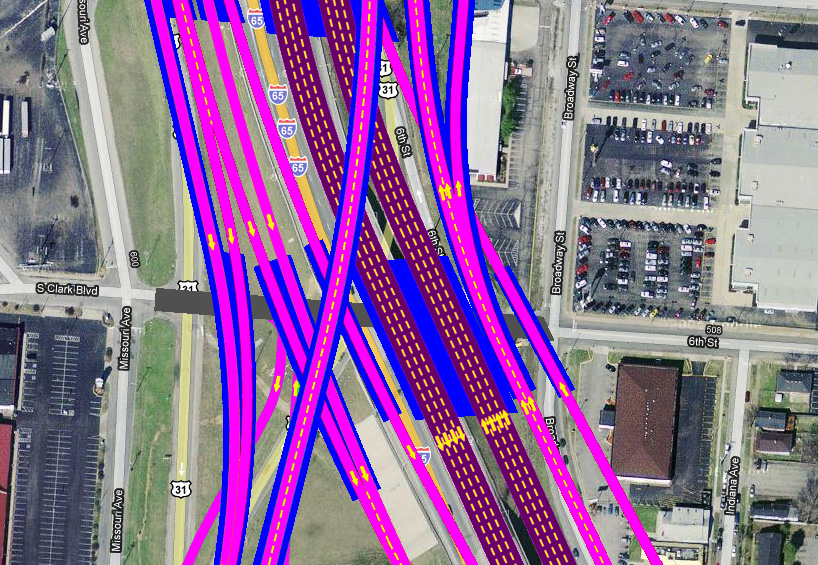
What’s more troubling, however, is that the Second Street Bridge has effectively been turned into an off-ramp for Interstate 65. If you look at the maps, it ceases to be a local access bridge and instead ties directly into the highway.
Next, imagine motorists barreling along an open straight-away at Interstate speeds and then onto the Second Street Bridge. There’s already a significant speeding problem already today and this is simply going to make it worse.
In the diagram below, the arrow is pointing to the merging area where the on-ramp from the street grid attaches to the bridge. Not only will this be dangerous for motorists, but potentially deadly for cyclists. The Second Street Bridge will turn into an expressway, and if the I-65 bridge is tolled and the 2nd Street bridge isn’t, you can imagine the problems that will ensue.
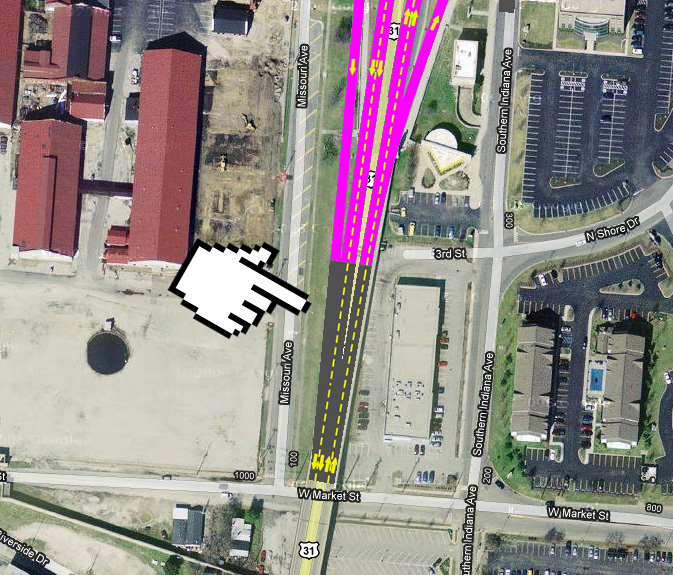
Next, lets take a closer look at what’s actually happening to one our most historic bridges: it’s being destroyed. It’s a little hard to see, but below is the current footprint of the Second Street Bridge overlaid on top of the ORBP plan. The arrow is pointing to two yellow dots representing the limestone pylons marking the entrance to the bridge.
Notice that the footprint of the now-a-highway-off-ramp bridge is over twice as wide as the existing bridge. What’s going to happen to the carved limestone pylons and the limestone guard rails by the sidewalk? And look at all the landscaped area to the west of the bridge that will be destroyed.
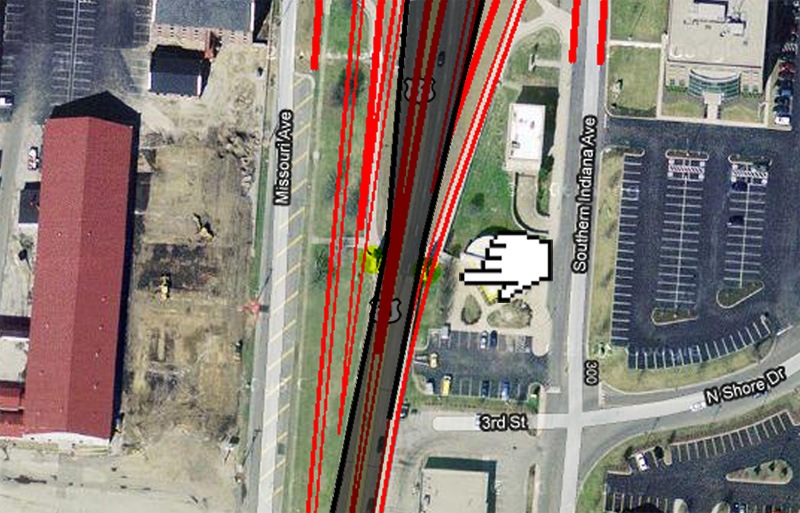
Everyone should by now be familiar with how bad the Spaghetti Junction is going to be at 24-or-so lanes running through the core of the city. But check out how badly Interstate 65 is going to tear apart Southern Indiana. Below is a larger map showing the highway headed for Louisville.
Those are lane counts that do not include space for shoulders or wasted swaths of land between ramps. Does Jeffersonville really need a 19-lane highway splitting it off from Clarksville?
When it comes down to it, the vast majority of the ORBP was never explained to the public and no one has any idea of how destructive this thing really is going to be. No one knows the extent to which it will change everything from Butchertown, to Slugger Field, to the Second Street Bridge.
Do we really want to cross the Second Street Bridge and land under 16 lanes of tangled highway? Do we really want to make cycling to Southern Indiana even more dangerous than it is today? Do we really want the Second Street Bridge to be an off-ramp for Interstate 65 and do we want to destroy the historic detailing that makes the bridge beautiful? How many lanes is enough?
This is out of control.
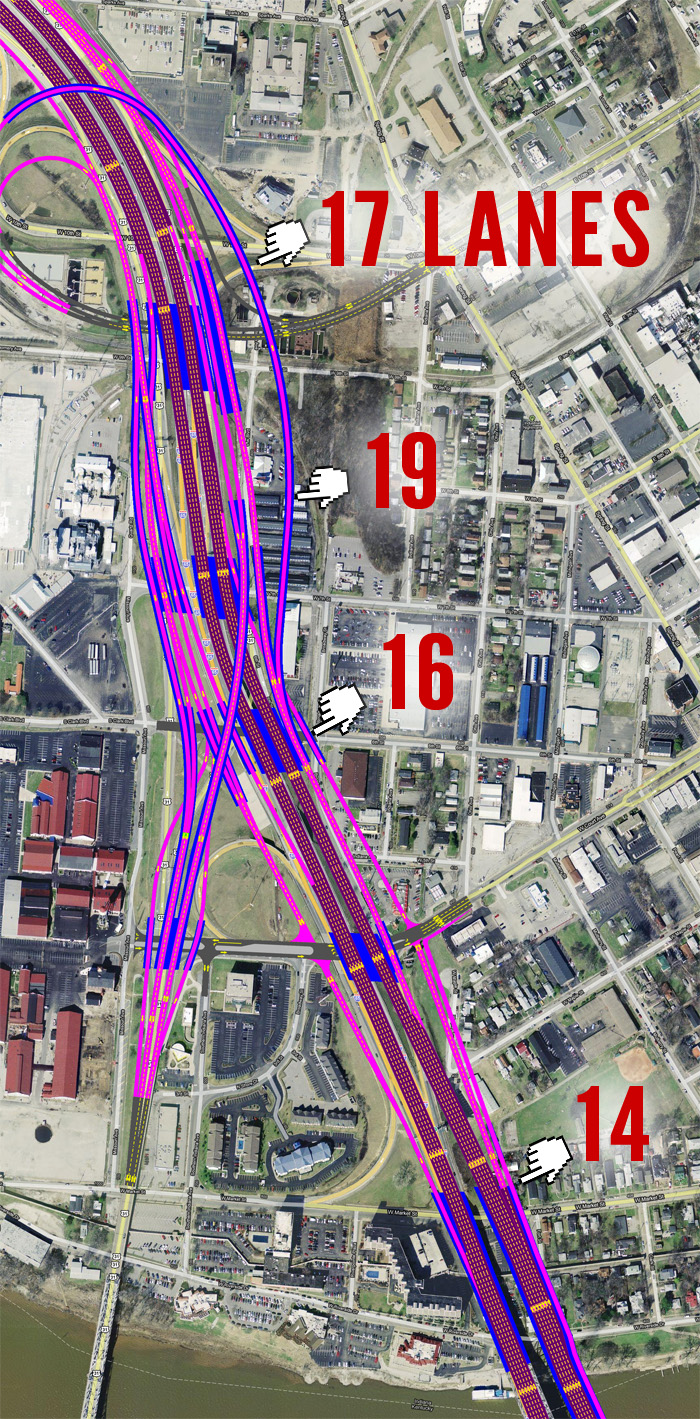



yet more evidence that traffic engineering is an efficiency field, with computations that don't include 'quality of life' issues.
I really want to see CGI videos of all that concrete as seen from ground level. I want to see what those caverns will look like. I want to see a list of the buildings that will be demolished.
Part of me thinks this will all never happen, that 15 years is a long time and that some people will wake up, that the political and economic climate will change. It will take relentless bombardment, relentless education, but I believe that if the first real moves are made towards building this thing, the first shovels go down, some people will wake up.
I support & am on the staff of Tyler Allen for Mayor, but it's a nifty little story how I met this guy. About 5 years ago, I was a hoosier transplant living in downtown Louisville. I was trying to enjoy a gallery hop one night when I wondered in 8664 headquarters. This little dude pulls out maps and illustrates for me what the ORBP will do not only to our great city, but also to my beloved homeland.
It was like taking the red pill from Morpheus.
Like Tyler, I'm passionate about building an East-End bridge, but not at the expense of our city's livability. There is not a consensus for a downtown bridge or a 23-lane concreted rooftop over Waterfront Park.
I am all for the preservation of our city. However, I do not think that simply building an east end bridge will solve all of our traffic problems in downtown. Spaghetti junction was poorly designed and is in dire need of repairs. What everyone doesn't seem to understand is that the majority of people in this city drive everywhere. If the road system is not adequate to handle the traffic load then it needs to be upgraded. Yes, light rail would be great to have but we do not have the population size to support it. Just look at TARC for a perfect example; cutting routes and raising fees because there aren't enough riders to support it. Also, by the time anything is built the Big Four bridge will be finished and would be able to handle all of the pedestrian and biker traffic.
Many have been calling for not just an East End Bridge, but also changes-in-place to Spaghetti Junction to fix its weaving issues. It doesn't have to be hyper-widened to 23 lanes and a second bridge added to address those real problems.
I understand that soon we'll hearing from somebody who will prove that Spaghetti Junction's bottlenecks can be fixed without a second bridge.
@Jeff H.
"What everyone doesn’t seem to understand is that the majority of people in this city drive everywhere."
Well duh. But ask yourself why? Could it be because of a massive government subsidy which ripped out the beating heart of our city, and poured concrete over the bleeding wound? And now they want to do it again (but have us pay this time), and some people are so closed-minded that they don't even understand that there's another way to do it?
You have to go all of 0 miles to find another city that did it another way. Just look at Louisville in 1920 to see a transit-based city with a *smaller* population. (albeit denser). That's actually a cool thing about transit – it makes things denser. You don't have to chauffeur your kid everywhere when your kid can walk on his own. And it was cheaper too – Louisvillians of that era spent less than 5% of their annual household income on transportation. Today's Louisivillians pay 25%. In some cases we pay much more – we've eliminated all transportation options that suit the old, the young, and those with disabilities that prevent them from driving – the cost to these citizens is almost incalculable. Furthermore, motoring creates enormous, existential threats to our health – it kills people in our streets at a much faster rate than transit, bicycling, or walking. So yes: more people choose to drive here than choose transit, walking, or bicycyling. But we have a vested interest in making the other choices more attractive for these people. It promotes our values of freedom, safety, personal independence, and equity.
One other thing. You wrote:
"Just look at TARC for a perfect example; cutting routes and raising fees because there aren’t enough riders to support it."
TARC is not designed, nor should it be designed to, run at a profit. It's not because the buses are empty that they're cutting routes. Many buses are turning away passengers! It's the local tax support that's shrinking – that's the problem!
Try this on for size:
"Just look at ORBP for a perfect example; they're cutting routes and raising fees because there aren't enough Gulf-rapists to support it". "Cutting routes" = service interruptions at Spagetti Junction to get the thing built. "Raising fees" = bridge tolls. "Gulf-rapist" = motorists, who are complicit in the Gulf of Mexico oil disaster.
What I'm trying to say is: things are tough all over. Not every option is equally good for our city or our people.
ORBP is the same expressway thinking that nearly gutted our city the first time around. Downtown expressways: it feels so good when you stop doing it.
Engineers design what they are asked to design by their management.
If they are asked to find a way to greatly reduce the bloated downtown portions of the ORBP, including removing the new bridge and simply fixing bottlenecks in the current Spaghetti Junction, they will find a way.
Quality of life issues have not yet entered the lexicon of the KYDOT. It’s kinda like how Mark Twain said he hope he is in KY when the apocalypse happens because everything there happens 20 years later. It is our job to force our leadership to wake up and realize that a city with 20th century infrastructure will not be able to compete in the 21st century and beyond. It is my understanding that the expected life of this infrastructure is 100 years, can anyone confirm this?
whoa. Good catch.
I’m actually a little fuzzy about bicycle access on that bridge right now. Proceeding northbound past the first IN traffic light, it feels like a left onto Clark Ave is not allowed, and that you MUST get onto the expressway. That’s an unbelievable routing inefficiency for all roadway users, not just bicycles.
To Dave Morse: Your post caused me to reflect on certain cohesive, vibrant neighborhoods that were bisected, in particular by the construction of the Watterson X-Way. What was once one, became fragmented & competitive and/or shunned. Neighborhoods all along its urban route, from east to west, were sliced into "north" & "south," preventing social interaction & dividing their interests & impact.
I recall trying to ride my bike from my parents' Hikes Point home to Assumption High School in the '60s, but finding it very daunting to cross the x-way ramps at Bardstown Rd. (BTW, Bardstown Rd. was still only 2 lanes wide during my first 2 years of high school.)
I don't buy into the argument that you have to have density to support lightrail. You have to have destinations that people want to reach. There are several corridors that could meet that requirement. The beauty of fixed rail lines is that because the infrastructure does not move, people are willing to invest along the line, thus creating density. It is true that you won't be very successful running a line through 10 miles of cornfield, but if you look at Louisville compared to other cities that have or are implementing lightrail and/or streetcar systems, they have densities similar if not less than Louisville. Charlotte, NC has what is touted as a success story for lightrail and if you have ever been there, it pails in comparison to the tight inner-ring neighborhoods of Louisville. When I moved here over ten years ago I was really excited about the thought that I was living in a progressive city that was preparing the T2 project and so many other things starting to happen. We need to be thinking seriously about real progress again.
The worst part is that the “mainstream” media bashes anyone who even tries to get the word out to the public about this horrific plan. The C-J called Tyler a political gadfly. I’ve know him for years and he is a very intellegent, hardworking, humble man. I’m so proud of anyone who is willing to go up against the power brokers in this region. Thanks “Broken Sidewalk” for all you do to help out!!
Jeff H. most people oppossed to the ORBP as currently designed are not against more local access bridges being built. Most are not against a waterfront parkway that moves traffic. Most are not against fixing spaghetti junction. However me and many others are oppossed to the terribly designed downtown ORBP that will make Louisville the laughingstock of the world. Talk to most urban planners knowledgeable of this issue and they will tell you that the downtown ORBP will be on the short list of the biggest urban planning mistakes of the 21st century. I for one will not live in the city of Louisville if this thing is built as currently designed and I will do everything possible to make this city's leaders realize they are about to make the biggest urban planning mistake of the 21st century.
Dave M, KY ranks 46th in state funding for public transportation with none of that $ going to Louisville, only states like Montana and Wyoming rank lower. It is going to be difficult to improve our public transit until that issue is addressed. The only realistic way for that to happen is for there to be a significant new source of state revenue that pulls in dollars from residents of other states. What's the answer? True casinos with profesional sports gaming. We already have all the negative effects of gambling in this area without any of the positives (those go to Indiana). Another positive of expanded gambling would be that Churchill Downs could be given the licences and transformed into the next giant casino/resort corporation that expands around the world. For KY and Churchill Downs to really compete on the world market we must have profesional sports (no college) gambling so that we can attract money/tourists from all over the midwest, northeast, and south. KY/Louisville is perfectly situated geographicly and has the advantage of not having any pro sports franchises that would object. Think about it, a chicago international grocery store owner would call his cousin to put $50 bucks down on a cricket game in India and the state of Kentucky would get 30-40% of the profits. We would definitely need another bridge downtown (local access with transit accomadations) to accomadate all the Hoosiers and others who would come to downtown Louisvillle or Churchill Hill Downs to subsidize our local and state government. We just need to figure out a way to get the religious fundamentalists to support or at least tolerate Louisville having another booster in its economic engine that subsidizes the majority of the state. I know someone is going to point out that, as of a few years ago, it is illegal for states that did not apply for an exemption (Nevada, Montana, and Oregon) to have sports gambling. Constitutional lawyers are in near unanimous agreement that this law would never hold up in court because pro sports gambling is not interstate commerce.
How about that three legged stood Build the Bridges Already commercial?
I just wanted to leave my two cents as an Indiana resident. I65 up here was expanded recently past exit 0 to exit 7, which expanded US31 off of I65 onto new adjacent roads. In the process of doing this, they eliminated the ONLY north bound entrance ramp for 4 miles into Indiana. Residents of Jeffersonville now have to drive through 4 miles of this adjacent US31 with lights every mile, not only that, but everyone who takes 2nd Bridge has to go through that as well.
If there is one thing that is good about this plan, it is putting that entrance ramp back in place.